Around this time of year, I always feel a little dry. My lips are chapped, my hands are scaly, and my wooden spoons are looking thirsty after months of mixing and stirring. It’s the perfect time to whip out a jar of spoon oil and give everything a good rub-down.
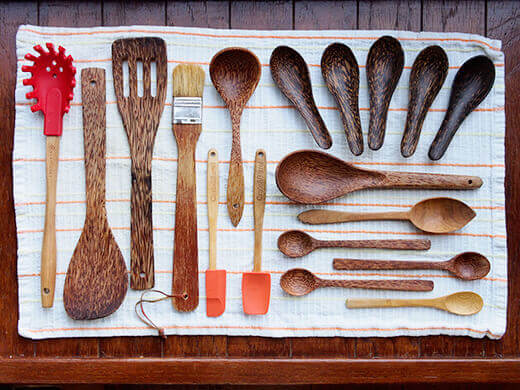
What is spoon oil?
Just like your skin, which feels fabulous and smooth after some silky conditioning, your wooden utensils are healthier, sturdier, and lovelier after a swipe of spoon oil. This hydrating mixture is sometimes also called spoon butter, wood butter, board butter, cutting board cream, or cutting board conditioner, because it works on all types of wooden things: spoons, turners, cutting boards, butcher blocks, bowls, trays, and utensil handles.
The mixture helps protect the wood from splits and cracks, and regular oiling offers a layer of water resistance. I often oil up my entire collection of wooden utensils when my hands are dry and overworked—usually early winter to late spring—because spoon butter moisturizes your skin as well!
My spoon butter (or as I like to call it, spoon butta!) is a mixture of walnut oil and beeswax. Walnut oil is known as a drying oil. That means it absorbs into the wood and then cures, or hardens. It gives the wood a satiny sheen that stands up to repeated use.
The beeswax adds another layer of protection and waterproofness. Together, they give new life to your parched wooden implements in a natural, effective, and food-safe way.
Behold the before and after…
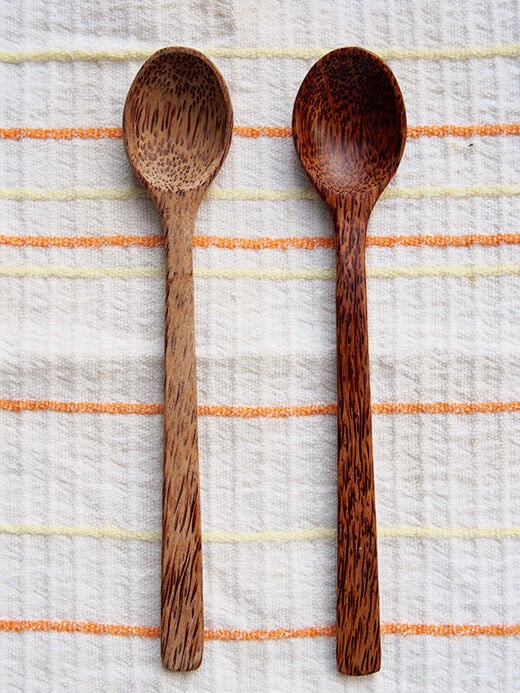
Walnut oil vs. mineral oil
A lot of commercial spoon butters are a mixture of mineral oil and a hard wax (usually carnauba or beeswax). Mineral oil is known as a non-drying oil, meaning it washes away easily because it never cures.
While it’s often the standard for wooden cutting boards and butcher blocks, where repeated application helps the oil sink into the layers of pores and cracks to condition the wood, it’s less effective on wooden spoons, wooden spatulas, and other wooden utensils that are constantly washed with soap.
While you can use my homemade spoon butter for your cutting boards, keep in mind that walnut oil will cure. While this sounds ideal, theoretically it means repeated application of walnut oil will simply build on top of each other, so the oil isn’t able to absorb and fully sink in to a thick chopping board or butcher block countertop.
If you have a thin wood cutting board, or you scrub your cutting board with soap every day (rather than just wiping it down), then spoon butter is a great way to keep it from splintering.
The walnut oil in my recipe is also a good alternative for people who want to avoid mineral oil, a petroleum by-product.
Keep a jar in the kitchen for not only spoons, but for your hands as a natural moisturizer too! I like to leave a jar on my counter just for this purpose (but always remember to reach in with clean fingers). Use twice a year on all kinds of wooden objects, but your go-to spoons should get buttered up every couple of months.
Will spoon butter go rancid?
Walnut oil is highly resistant to oxidation (it’s used by many woodworkers for this reason) and your homemade spoon butter will keep for at least a year at moderate room temperature.
If you’re not able to source walnut oil, you can use another edible oil that’s high in linoleic acid (the property that causes it to cure) such as sunflower oil, though it’s more prone to going rancid.
To prolong the shelf life of any oil, you can add the contents of a vitamin E capsule to your spoon butter.
Disclosure: If you shop from my article or make a purchase through one of my links, I may receive commissions on some of the products I recommend.
Homemade spoon oil (board butter)
Makes 1 pint
Ingredients
8 fluid ounces walnut oil
2 ounces beeswax, cut into chunks (or 2 ounces beeswax pellets/pastilles
)
1 vitamin E capsule (optional)
Instructions
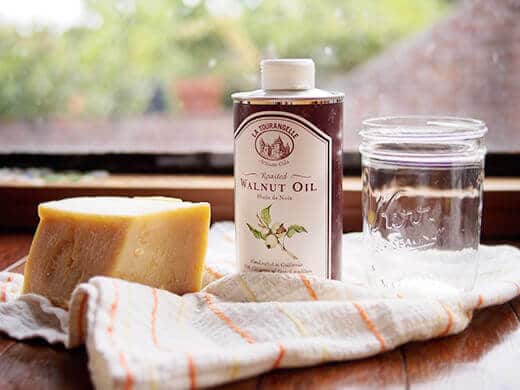
Any brand of walnut oil will work; I simply use what’s available in my local store. I also use a wide-mouth mason jar to make it easier to scoop from.
Pour the walnut oil and beeswax into a pint-sized glass jar, then place the jar in a saucepan filled with 2 to 3 inches of water.
Heat the jar over medium heat, stirring until the oil and wax are well mixed. (I use one of my wooden spoons to get ahead of the game!) You want the water to be simmering, not boiling.
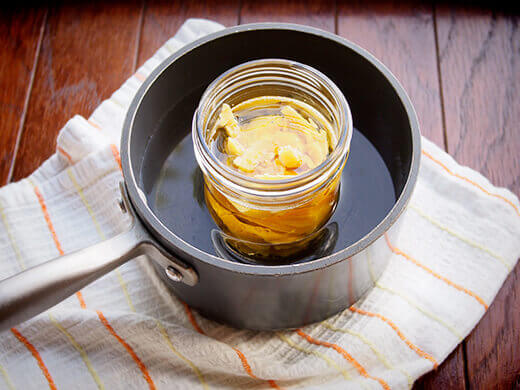
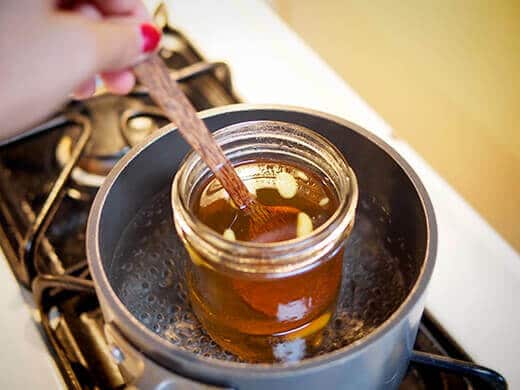
When the mixture has liquefied, remove the jar from the pan.
If using, break the vitamin E capsule and squeeze the oil into the mixture. Stir to combine, then wipe down your stirring spoon to ensure it’s evenly coated with the spoon oil.
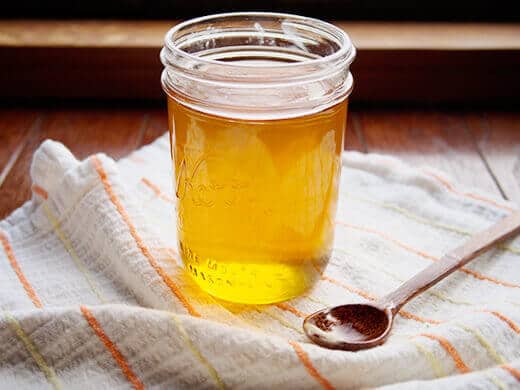
Allow the spoon oil to cool before using; it will thicken and solidify to a balmy texture.
When you’re ready to start spoon-buttering, simply swipe a (clean) spoonful or fingerful of the butter onto your wooden spoons, handles, and other utensils and give them a good rub-down. Let the oil absorb overnight, then buff out any excess oil the next day with a soft rag.
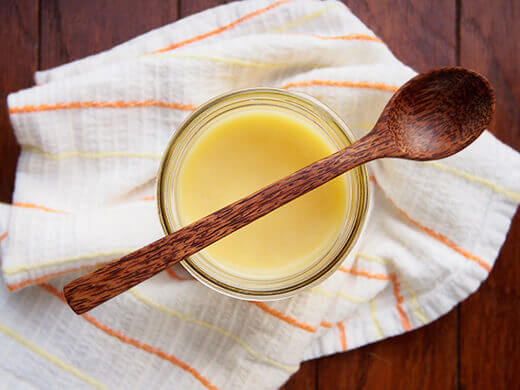
Homemade spoon butter makes a thoughtful gift for an avid cook, so you can also divide the recipe between two half-pint jars for two of your favorite people!
Homemade spoon oil (board butter)
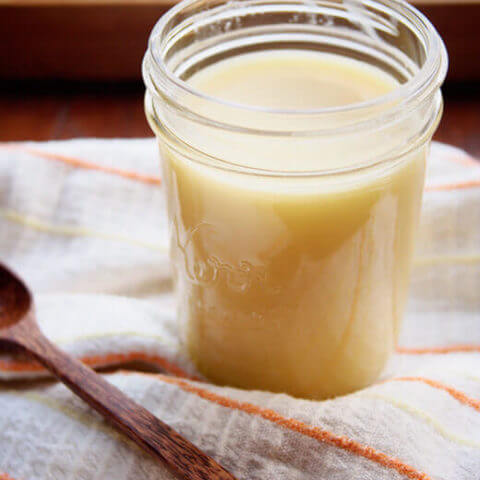
Spoon oil (also known as spoon butter or board butter) helps protect your wooden spoons, wooden spatulas, and other wooden utensils from splits and cracks, and regular oiling offers a layer of water resistance.
Materials
- 8 fluid ounces walnut oil
- 2 ounces beeswax, cut into chunks (or 2 ounces beeswax pellets/pastilles)
- 1 vitamin E capsule (optional)
Instructions
- Pour the walnut oil and beeswax into a pint-sized glass jar.
- Place the jar in a saucepan filled with 2 to 3 inches of water.
- Heat the jar over medium heat, stirring until the oil and wax are well mixed. (I use one of my wooden spoons to get ahead of the game!) You want the water to be simmering, not boiling.
- When the mixture has liquefied, remove the jar from the pan. If using, break the vitamin E capsule and squeeze the oil into the mixture. Stir to combine, then wipe down your stirring spoon to ensure it's evenly coated with the spoon oil.
- Allow the spoon oil to cool before using; it will thicken and solidify to a balmy texture.
Notes
To use, simply swipe a (clean) spoonful or fingerful of the butter onto your wooden spoons, handles, and other utensils and give them a good rub-down. Let the oil absorb overnight, then buff out any excess oil the next day with a soft rag.
This post updated from an article that originally appeared on November 6, 2013.
View the Web Story on DIY spoon oil and board butter.


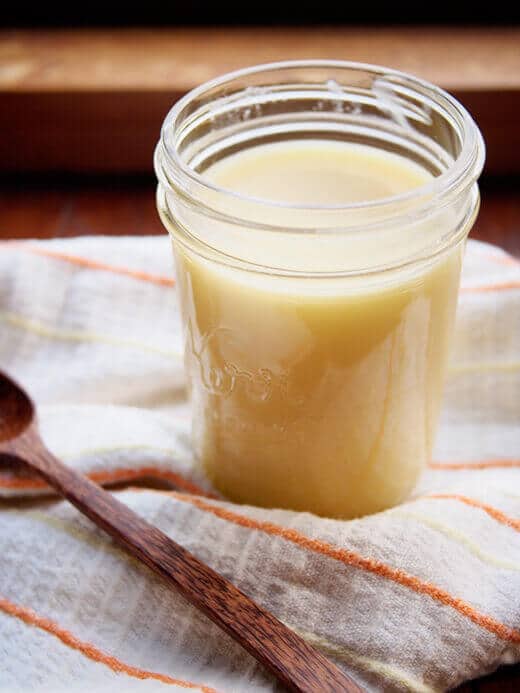

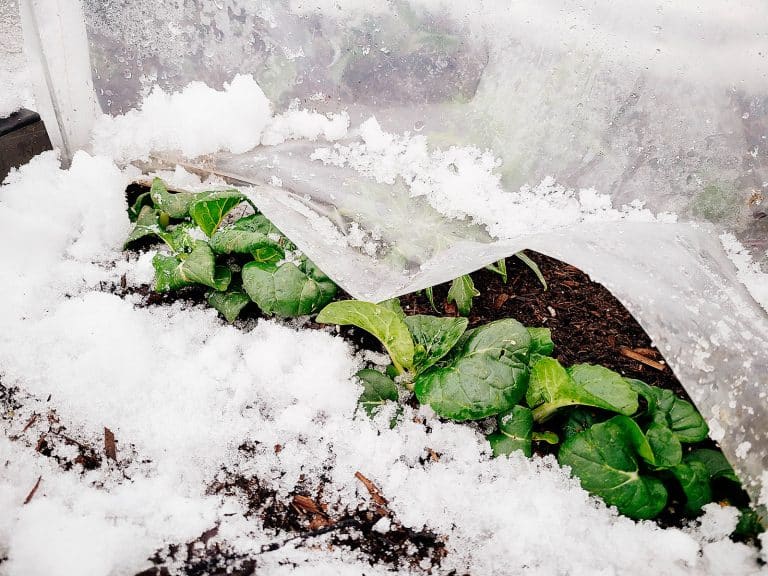
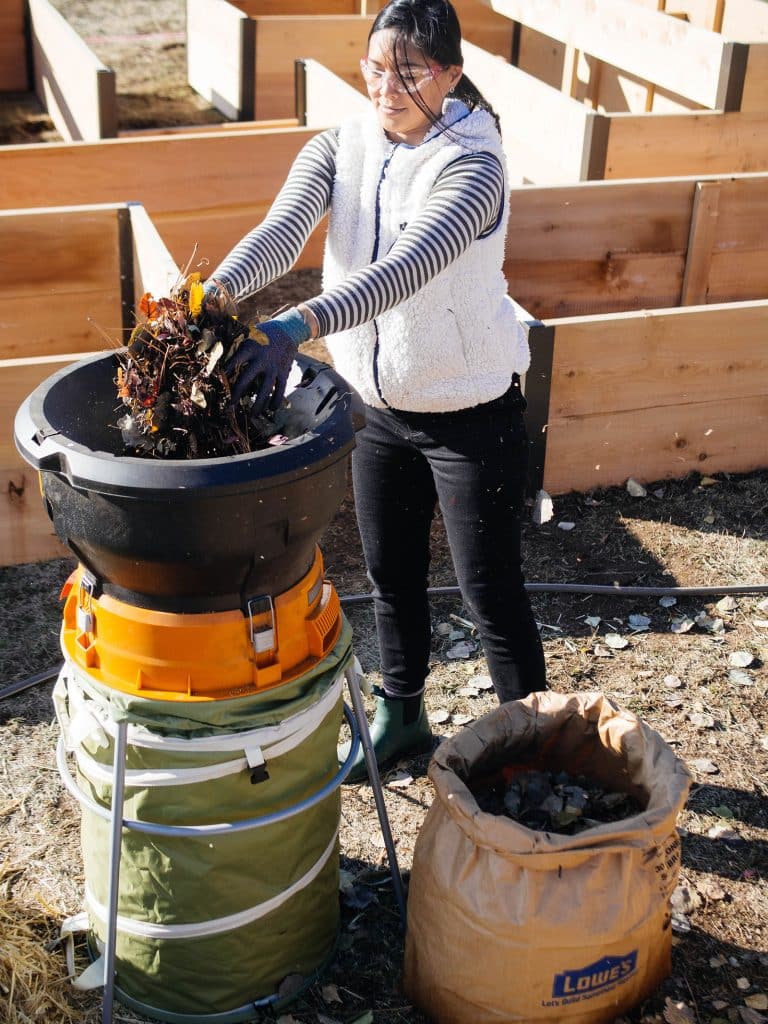
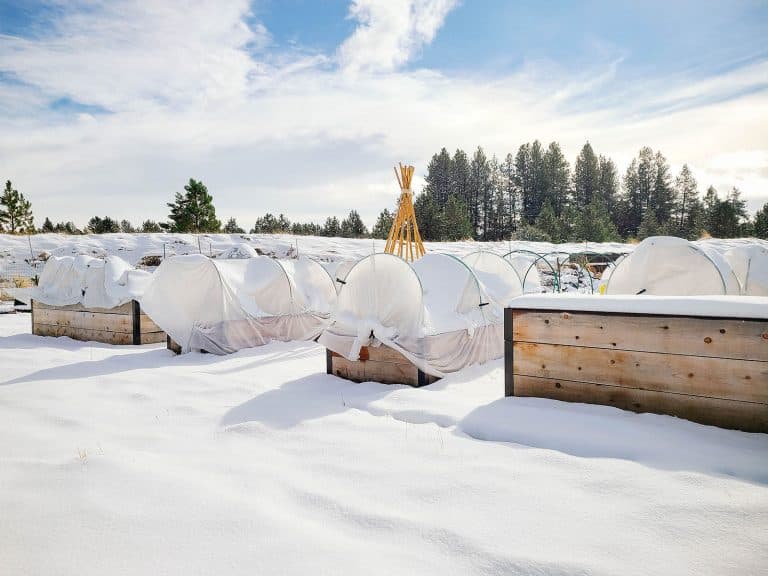






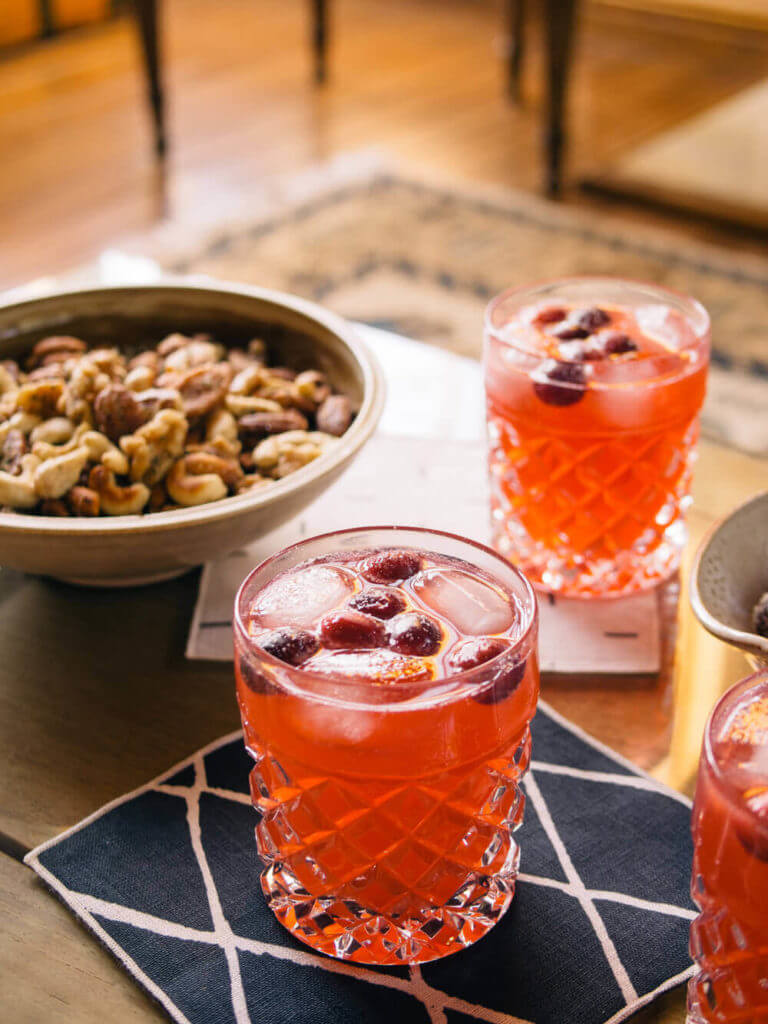
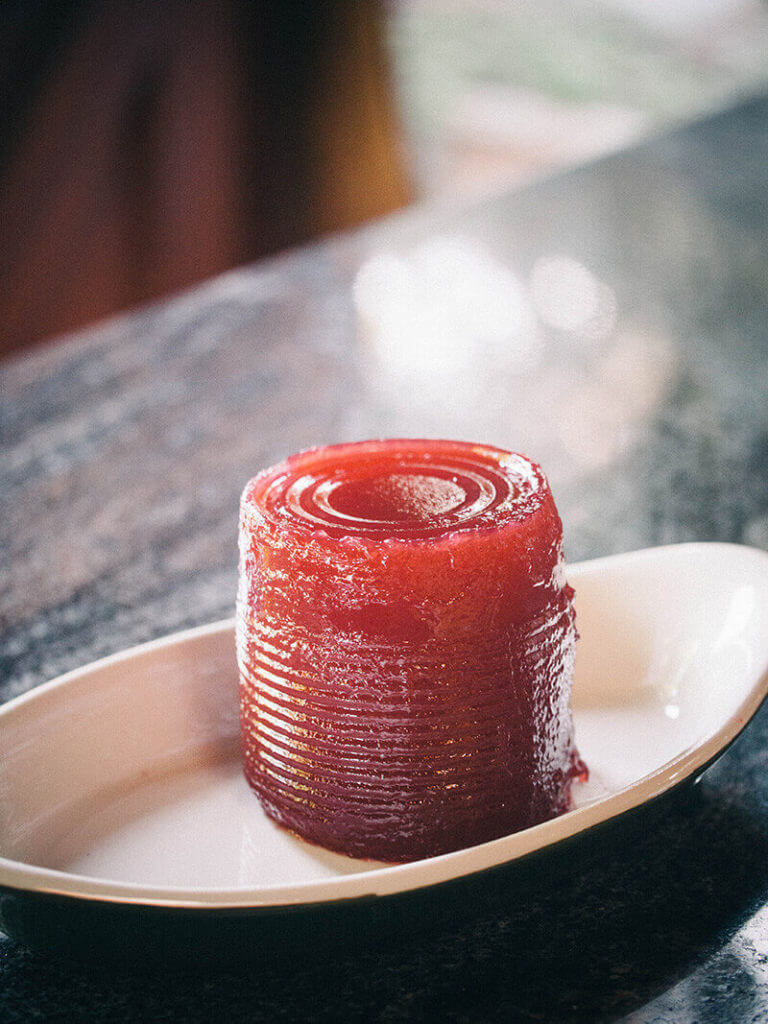

I happened to have a beeswax cake on hand that I figured I was never going to use, so I tried this on an old thrifted bread bowl that I scrubbed and sanded the daylights out of, and it’s lovely! Wish I could post a before and after! Thanks :). Smells more like roasted walnuts than beeswax (my store only had the same walnut oil you use), but it’s certainly not a bad smell and I love knowing for sure it’s food safe and won’t stay as sticky as olive oil.
I’m so glad to hear your bread bowl was given a new life. 🙂
Hi, Linda. Question: when we made this spoon butta (LOL) at home, we didn’t have any pint-sized jars, and therefore had to pour it into a jar that was around twice the necessary size. Is it possible to melt this stuff back down and pour it into another jar without affecting or otherwise destroying the recipe?
Will the wax wash off in hot water like tea or coffee? I know wax melts with heat… I am making several wooden coffee stirring spoons for gifts and I need something that won’t come off with hot liquid.
Thank you so much for this article. I have been making fabric wax with beeswax and walnut oil at a different ratio. I’m gonna try adding some vitamin e to the mix and see what happens! I do a lot of wood working too, and will probably use this mix to finish some pieces. I’m working on some leather beeswax, too, but I will need a different ratio with a non drying oil that is resistant to oxidize. Any suggestions? Thanks!
I’m not familiar with leather beeswax, but maybe try sweet almond oil? Good luck with your project!
Hi Linda thank you for the recipe! I’m new to wood carving and have recently come into a wooden soap dish that hasn’t been treated yet for use. Will your walnut Oil and beeswax butta work in this case? Thank you, Fiona
Yes, absolutely!
Hi Linda,
Great article. A couple of quick questions for you.
1. I noticed that you have LaTourangelle walnut oil in the article photo. Does roasting walnut oil impact the consistency of the finish? Are there non-roasted options available and would you choose one over the other?
2. Walnut oil has a pretty strong taste, and I know a few people that wouldn’t use it on ‘eaters’ (functional versus decorative spoons) or on the inside of wooden mugs. Does the wax minimize or change the taste much?
Thanks!
Stewart
I use LaTourangelle because it’s readily available at my local supermarket. I haven’t tried any other brands, but as far as I can tell, no flavor transfers on to any of my utensils (and they are all “eating” utensils like servers, stirrers, and soup spoons; none are decorative). Only a very thin coat of spoon butter is needed. If you’re overly sensitive to walnut oil, you might want to try it on just a couple of utensils/mugs first to see if you can pick up the taste.
Hi. Great article. I just bought bamboo utensils, and I think I will try your butta on them. Concerning cutting boards, I also bought a couple of bamboo cutting boards. They are quite thin, no where near what I would call a “chopping block.” (The brand is “Bambu,” their “undercut” series.) Do you think the butta would be ok on a thinner board? Thank you!
Yes, you can definitely use the butta on a thinner board!
Have you ever used an oil other than walnut oil? My husband is allergic to walnut. I’m going to try it and see if he reacts, but it would be good to know of an alternate oil that would work with the beeswax. Thanks!
I personally have not, but you can certainly use another drying oil. Unfortunately, these drying oils are nut oils, such as boiled linseed and tung. This may or may not work for you if your husband is allergic to all nuts. Alternatively, you can just use a vegetable oil for your spoon butter. Since vegetable oils don’t dry, they’re more of a wood conditioner and not a wood finish. It just means you’ll have to condition your wood more frequently, since a soap and water scrub will wash away the oil.
This sounds like a great product. I’m going to try it. But linseed oil is from flax seeds, not a nut. I think it should be safe for someone with a nut allergy.
You are absolutely correct and I mistyped my earlier comment. Tung oil is from tree nuts, boiled linseed oil is from cereal seed. (But food-grade linseed oil — flax seed oil — may be processed in facilities that also process tree nuts.)
Sivaploy Limrat liked this on Facebook.
Dawn Singh liked this on Facebook.
Mindy Phillips liked this on Facebook.
Matti Salomaki liked this on Facebook.
Thanks so much for sharing your expertise regarding the making of spoon butter. I especially appreciated how you made the distinction between different oils and described their specific properties and applications. I’m definitely adding you to my favorites list!
Thank you for reading my blog! I’m glad you’ve found something useful here!
I was reading your post about oiling wooden spoons. I am carving some for myself and maybe to sell. They are not treated with anything yet, the wood is smooth and hard. I wondered about the walnut oil and using walnut for the wood. Will it cause nut allergies? Any ideas, I have put many days in making them and want them done right.
It’s hard to say. Most nut allergies come from peanuts, which are actually legumes and not nuts at all. But tree nut allergies are out there. I know that a protein in walnut causes the allergy, but as to how potent that protein is once it’s cured in your spoons (or whether it still exists if you’re using heated or treated walnut oil) is something you have to consider. If you do use it, I think a warning that your products are finished with walnut oil would be a good idea.
Thank you kindly for the information, during the research I found some allergy issues so I will sell spoons that are natural and the owner may choose an oil. I have always used beeswax alone, but like your recipe for me 🙂 thanks
I wish I had read your post before going to Ikea. I purchased this walnut oil, but read it was roasted and had ground walnut shell in it. Not sure whether to purchase plain walnut oil(if it’s different), I happened upon Skydd(Ikea’s brand of mineral oil) for only $5 for a 17oz bottle.
Oh well…I’ll try it for my butta and save the other for food considering you can’t really eat mineral oil.
The Skydd will likely last you a long time, but for future reference, food-grade mineral oil is often sold in the beauty aisle of a drugstore for much less than the mineral oil sold as wood conditioner. The only difference between the two is that manufacturers will sometimes add essential oils or other things to their wood conditioning mineral oil. It’s more about marketing than functionality.
Thank you.
Since you used roasted walnut oil, did you have any problems with the walnut grains?
If you’re referring to the roasted walnut oil from La Tourangelle, I believe the oil is filtered, as I didn’t see any sediment floating around before or after heating.
Thanks.
Nice spoon collection! I’m looking around for something to put on a outdoorsy wooden knife handle and am thinking of doing something similar to what you did with the walnut oil and beeswax, what would you say the texture or ‘grippyness’ of the spoons are after applying the finish? Are they slick or grippy or not much difference either way? I don’t want the knife handle to be slippery or anything like that. Thanks a bunch for any help.
It feels silky/velvety, but not slick.
Hi! I was wondering if you have used spoon butta for bamboo utensils or cutting boards?
Yes, it works great on bamboo!
I’ve got a block of beeswax, what method do you use to cut off the desired amount? I just did it with a warm knife, but it was extremely difficult. Thanks.
I use a large chef’s knife; I make a few cuts as far as the knife will go, then break off the pieces with my fingers.
Just 2 ingredients to make this conditioning wood butter. Homemade Spoon Oil (Or As I Like to Call It, Spoon Butta!) http://t.co/O1NQsOXxhq
A natural moisturizer for your spoons (and your hands!). Homemade Spoon Oil (Or As I Like to Call It, Spoon Butta!) http://t.co/niViXxPyfL
This clearly makes a big difference! Thanks for the recipe 🙂 Can I ask where you got your gorgeous spoon collection from? I love the flecks of darker wood in them.
Those were collected on my travels through Vietnam. I haven’t been able to find any like them here in the States, which is unfortunate because I need to replace a few of the well-worn ones!
That’s a shame you haven’t been able to replace them. I’ve never seen anything like them here in the UK before either. Oh well, I was considering Vietnam as a travel destination for my next adventure, so I might yet be able to pick something up! 🙂
Most of those were purchased from the market stalls at Cho Lon (the main market in Saigon). I’m long overdue for another trip out there. 🙂
Thanks for that! I’ll have a wee look at the possibility of visiting Cho Lon. I’m also considering Bali, but I reckon they’d have similar gorgeous crafted things to buy too.
Butter up your wooden spoons to keep them long-lasting. Homemade Spoon Oil (Or As I Like to Call It, Spoon Butta!) http://t.co/8G79iO5TcR
Extravagant Gardens liked this on Facebook.
Good for your spoons, and good for your skin, too. Homemade Spoon Oil (Or As I Like to Call It, Spoon Butta!) http://t.co/7xf8jvtmdQ #recipe
Matti Salomaki liked this on Facebook.
Thanks for a great homemade recipe. I’ve always rubbed my spoons and knife handles down with olive oil, but I’ll try this now.
Caroline
Looks easy enough, I will try 🙂
Mindy Phillips liked this on Facebook.
Sivaploy Lim liked this on Facebook.
Dawn Singh liked this on Facebook.
Homemade Spoon Oil (Or As I Like to Call It, Spoon Butta!):
Around this time of year, I always feel a little … http://t.co/sBB5MI2Nlp